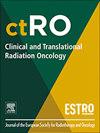Urethral and bladder dosimetry and urinary toxicity in prostate cancer patients undergoing SBRT with and without intra-prostatic boost
IF 2.7
3区 医学
Q3 ONCOLOGY
引用次数: 0
Abstract
Background and purpose
To evaluate the dosimetric and toxicity profiles of stereotactic body radiotherapy (SBRT) for prostate cancer, comparing cohorts with and without intraprostatic boost (IPB) to assess feasibility and safety of IPB, with particular attention to urethral and bladder dose and toxicity.
Materials and methods
This retrospective cohort study analyzed 349 patients with localized prostate cancer treated between 2018 and 2023. Of these, 266 received SBRT with IPB, and 83 received SBRT without IPB. Patients were treated using a robotic SBRT platform with fiducial tracking. Dosimetric parameters for the urethra, including D0.03cc, D0.3cc, and V40Gy, and for the bladder, including D0.03cc, D5cc, D10cc, and V37Gy, were evaluated. Acute and late toxicities were assessed using CTCAE criteria.
Results
For the urethra, median values for D0.03cc, D0.3cc, and V40Gy, and for the bladder, median values D0.03cc, D5cc, D10cc, and V37Gy were compared and no statistically significant differences were observed between the two cohorts. Late urinary toxicity of grade 3 or higher occurred in 2.25 % of patients in the IPB group and 2.47 % in the no IPB group, with no grade 3 acute toxicities reported.
Discussion
These findings support the use of SBRT using an IPB as a feasible and safe approach to achieve focal dose escalation to dominant intra-prostatic lesions (DILs) without significantly increasing urethra or bladder dose or toxicity. Future research should focus on standardizing DIL contouring, exploring adaptive planning techniques to increase accuracy, and prospectively studying toxicity and quality of life in patients treated with IPB with SBRT.
前列腺癌患者行SBRT伴或不伴前列腺内灌注的尿道和膀胱剂量测定及尿毒性
背景与目的评价立体定向体放疗(SBRT)治疗前列腺癌的剂量学和毒性特征,比较有和没有前列腺内增强(IPB)的队列,以评估IPB的可行性和安全性,特别关注尿道和膀胱剂量和毒性。材料和方法本回顾性队列研究分析了2018年至2023年接受治疗的349例局限性前列腺癌患者。其中,266例接受了带IPB的SBRT, 83例接受了不带IPB的SBRT。患者使用具有基准跟踪的机器人SBRT平台进行治疗。评估尿道剂量学参数(D0.03cc、D0.3cc、V40Gy)和膀胱剂量学参数(D0.03cc、D5cc、D10cc、V37Gy)。采用CTCAE标准评估急性和晚期毒性。结果尿道D0.03cc、D0.3cc、V40Gy的中位值比较,膀胱D0.03cc、D5cc、D10cc、V37Gy的中位值比较,两组间无统计学差异。IPB组2.25%的患者出现3级或以上的晚期尿毒性,未IPB组2.47%的患者出现3级或以上的晚期尿毒性,未报告3级急性毒性。这些研究结果支持在IPB下使用SBRT作为一种可行且安全的方法来实现局灶剂量升级到主要的前列腺内病变(DILs),而不会显著增加尿道或膀胱剂量或毒性。未来的研究应侧重于标准化DIL轮廓,探索适应性规划技术以提高准确性,并前瞻性地研究SBRT治疗IPB患者的毒性和生活质量。
本文章由计算机程序翻译,如有差异,请以英文原文为准。
求助全文
约1分钟内获得全文
求助全文
来源期刊

Clinical and Translational Radiation Oncology
Medicine-Radiology, Nuclear Medicine and Imaging
CiteScore
5.30
自引率
3.20%
发文量
114
审稿时长
40 days
 求助内容:
求助内容: 应助结果提醒方式:
应助结果提醒方式:


